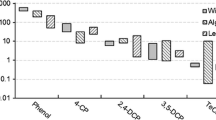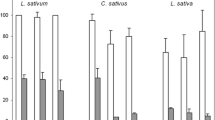Abstract
A short-term acute toxicity assay for willow trees growing in contaminated solution or in polluted soil was developed and tested. The test apparatus consists of an Erlenmeyer flask with a prerooted tree cutting growing in it. Growth and reduction of transpiration are used to determine toxicity. Transpiration is closely related to photosynthesis and growth, but is easier and faster to measure and can be measured without disturbance of the test system. Plants are grown for 24 h in uncontaminated nutrient solution before the toxicant is added to determine the initial transpiration. The loss of weight is expressed as % decrease after 48 and 72 h or longer compared to the initial transpiration, divided by the transpiration of control plants. More toxicity parameters are growth and water use efficiency of the plants. The sensitivity of the test was evaluated with 3,5-dichlorophenol. EC50 values between 5.8 and 9.6 mg/L were found. This is similar to the results from algal growth rate tests. The willow tree toxicity test may be useful for determining the site-specific toxicity of polluted soils and for terrestrial risk assessment of new chemicals and pesticides.
Similar content being viewed by others
Author information
Authors and Affiliations
Additional information
Received: 8 November 1999/Accepted: 28 February 2000
Rights and permissions
About this article
Cite this article
Trapp, S., Zambrano, K., Kusk, K. et al. A Phytotoxicity Test Using Transpiration of Willows. Arch. Environ. Contam. Toxicol. 39, 154–160 (2000). https://doi.org/10.1007/s002440010091
Issue Date:
DOI: https://doi.org/10.1007/s002440010091




